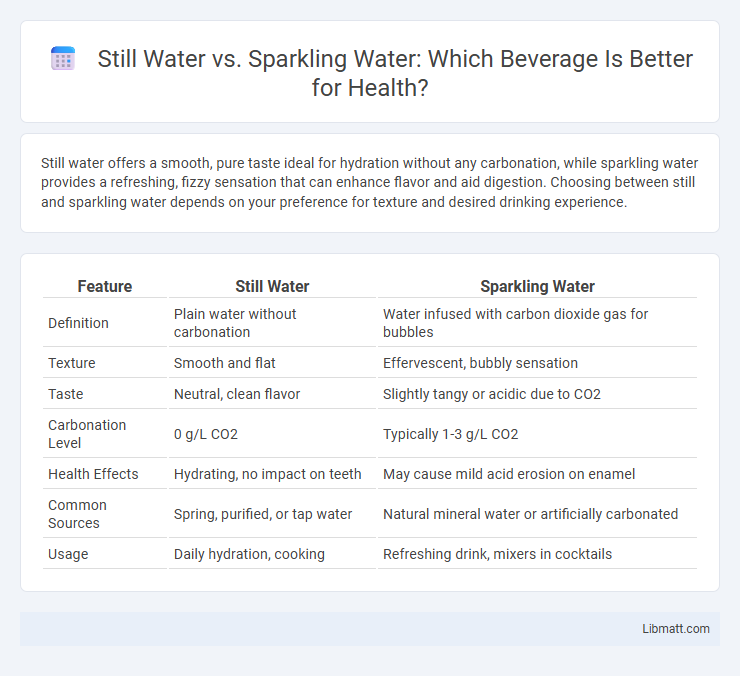Still water offers a smooth, pure taste ideal for hydration without any carbonation, while sparkling water provides a refreshing, fizzy sensation that can enhance flavor and aid digestion. Choosing between still and sparkling water depends on your preference for texture and desired drinking experience.
Table of Comparison
| Feature | Still Water | Sparkling Water |
|---|---|---|
| Definition | Plain water without carbonation | Water infused with carbon dioxide gas for bubbles |
| Texture | Smooth and flat | Effervescent, bubbly sensation |
| Taste | Neutral, clean flavor | Slightly tangy or acidic due to CO2 |
| Carbonation Level | 0 g/L CO2 | Typically 1-3 g/L CO2 |
| Health Effects | Hydrating, no impact on teeth | May cause mild acid erosion on enamel |
| Common Sources | Spring, purified, or tap water | Natural mineral water or artificially carbonated |
| Usage | Daily hydration, cooking | Refreshing drink, mixers in cocktails |
Introduction to Still Water and Sparkling Water
Still water, also known as flat water, contains no carbonation and is sourced from natural springs or purified through filtration processes. Sparkling water is infused with carbon dioxide gas, creating bubbles that provide a fizzy texture and a tangy taste, often derived from natural mineral springs or artificially carbonated. Both types offer hydration but differ significantly in sensory experience and mineral content.
What Defines Still Water?
Still water is defined as water that contains no carbonation or dissolved carbon dioxide gas, resulting in a flat, non-bubbly texture. It is often sourced from natural springs, wells, or purified tap water, and is typically free from additives. The absence of bubbles distinguishes still water from sparkling water, making it a preferred choice for hydration and culinary uses where a neutral taste is desired.
What Is Sparkling Water?
Sparkling water, also known as carbonated water, is water that has been infused with carbon dioxide gas under pressure, creating bubbles and a fizzy texture. It often contains natural or artificial flavors and minerals, enhancing its taste compared to still water, which is plain and non-carbonated. If you prefer a refreshing, bubbly drink with the same hydration benefits as still water, sparkling water offers a flavorful alternative.
Key Differences Between Still and Sparkling Water
Still water is plain water with no carbonation, providing a smooth and natural hydration experience without bubbles or fizz. Sparkling water contains dissolved carbon dioxide gas, creating effervescence that gives it a fizzy texture and distinct mouthfeel. Your choice depends on preference for taste and sensation, with still water often preferred for hydration and sparkling water favored for its refreshing, bubbly character.
Taste and Sensory Experience
Still water offers a smooth, pure taste with a flat, gentle mouthfeel that highlights subtle mineral notes, providing a refreshing and calming sensory experience. Sparkling water delivers a lively effervescence with sharp carbonation bubbles that create a tingling sensation on the palate, enhancing the perception of crispness and acidity. The carbonation in sparkling water often enhances flavors and can mask any metallic or flat tastes, making it a preferred choice for those seeking a more dynamic and invigorating drink.
Health Benefits of Still Water
Still water is essential for maintaining optimal hydration, supporting kidney function by efficiently flushing out toxins and reducing the risk of kidney stones. It aids in regulating body temperature, promoting healthy digestion, and enhancing skin elasticity through proper cellular hydration. Unlike sugary or carbonated drinks, still water contains no calories or additives, making it the healthiest choice for sustained energy and overall wellness.
Health Benefits of Sparkling Water
Sparkling water offers hydration benefits similar to still water while providing a bubbly texture that may enhance digestion and reduce indigestion symptoms. It contains carbon dioxide, which can promote feelings of fullness and aid in managing appetite for weight control. Your choice of sparkling water with no added sugars or artificial flavors ensures you gain these health benefits without extra calories.
Potential Drawbacks and Myths
Still water lacks carbonation, which some believe is less effective for digestion, but scientific evidence shows it hydrates just as well as sparkling water. Sparkling water can cause bloating or gas in sensitive individuals due to carbon dioxide but generally poses no health risks. Myths about sparkling water harming teeth are often exaggerated; while acidic, it is less erosive than sugary sodas and safe when consumed in moderation.
Environmental Impact and Packaging
Still water typically has a lower environmental impact compared to sparkling water due to less intensive carbonation processes and reduced energy consumption during production. Packaging for both often relies on single-use plastic bottles, but glass and aluminum cans for sparkling water offer better recyclability and reduced carbon emissions if properly recycled. Choosing brands with sustainable packaging initiatives, such as using recycled materials or encouraging bottle returns, significantly mitigates the environmental footprint of both still and sparkling water.
Choosing the Right Water for Your Lifestyle
Still water provides pure hydration with no carbonation, making it ideal for daily consumption and soothing sensitive digestive systems. Sparkling water offers a bubbly, refreshing alternative that can enhance social occasions and support those who enjoy fizzy beverages without added sugars. You can select the type of water that best complements your lifestyle and hydration preferences, balancing taste and digestive comfort.
Still water vs sparkling water Infographic

 libmatt.com
libmatt.com